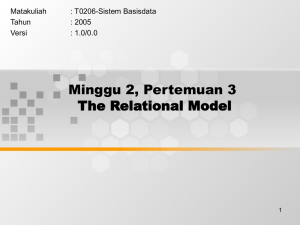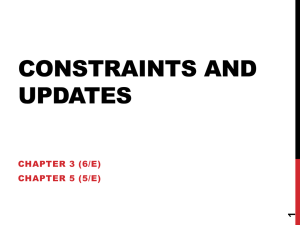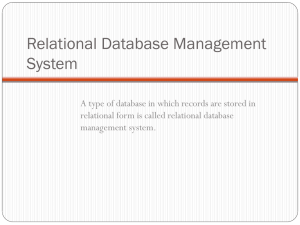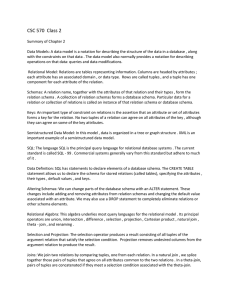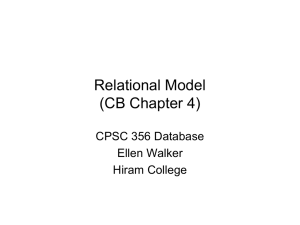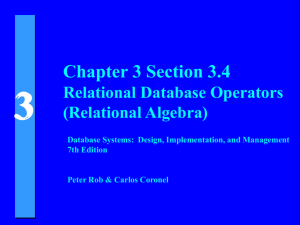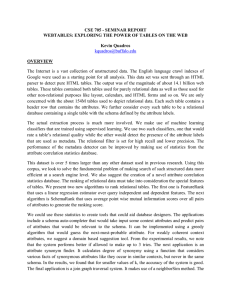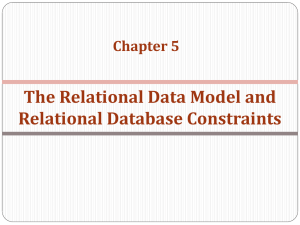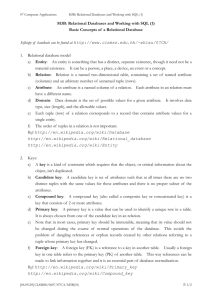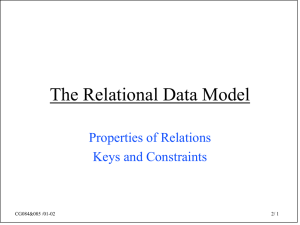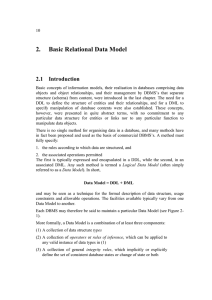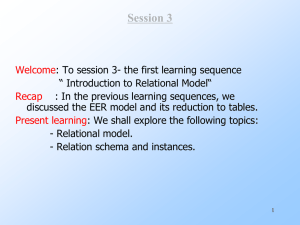The Relational Models two
advertisement
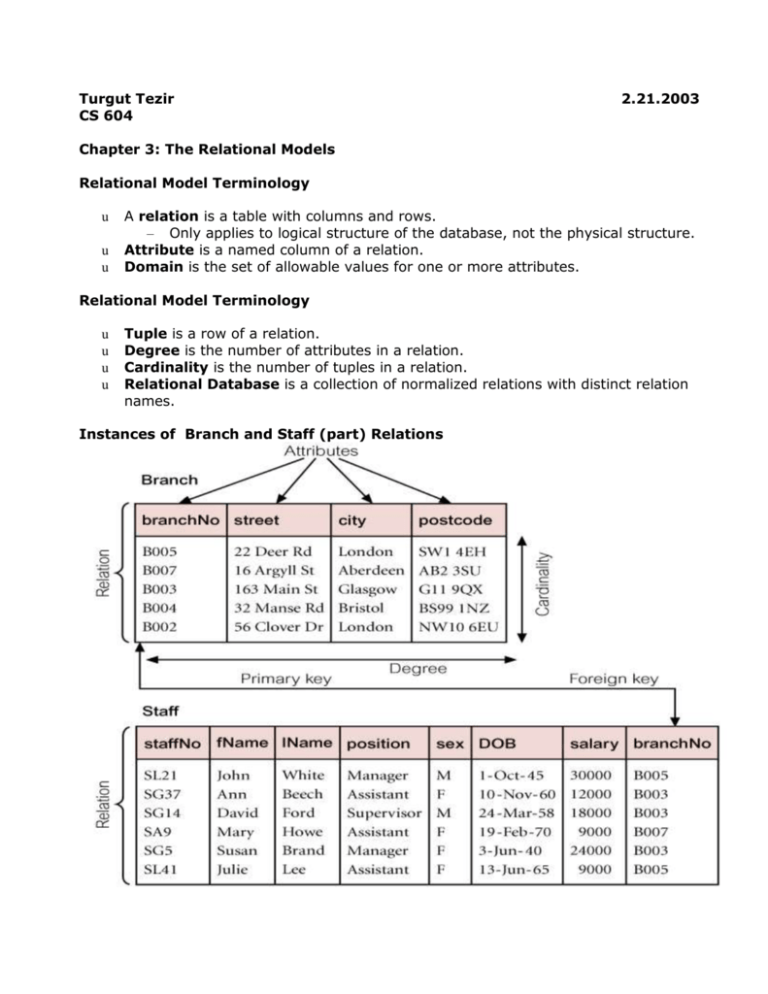
Turgut Tezir
CS 604
2.21.2003
Chapter 3: The Relational Models
Relational Model Terminology
u
u
u
A relation is a table with columns and rows.
– Only applies to logical structure of the database, not the physical structure.
Attribute is a named column of a relation.
Domain is the set of allowable values for one or more attributes.
Relational Model Terminology
u
u
u
u
Tuple is a row of a relation.
Degree is the number of attributes in a relation.
Cardinality is the number of tuples in a relation.
Relational Database is a collection of normalized relations with distinct relation
names.
Instances of Branch and Staff (part) Relations
Examples of Attribute Domains
Alternative Terminology for Relational Model
Mathematical Definition of Relation
u
u
Consider two sets, D1 & D2, where D1 = {2, 4} and D2 = {1, 3, 5}.
Cartesian product, D1 ´ D2, is set of all ordered pairs, where first element is
member of D1 and second element is member of D2.
D1 ´ D2 = {(2, 1), (2, 3), (2, 5), (4, 1), (4, 3), (4, 5)}
u
u
u
u
Alternative way is to find all combinations of elements with first from D1 and
second from D2.
Any subset of Cartesian product is a relation; e.g.
R = {(2, 1), (4, 1)}
May specify which pairs are in relation using some condition for selection; e.g.
– second element is 1:
R = {(x, y) | x ÎD1, y ÎD2, and y = 1}
– first element is always twice the second:
S = {(x, y) | x ÎD1, y ÎD2, and x = 2y}
Consider three sets D1, D2, D3 with Cartesian Product D1 ´ D2 ´ D3; e.g.
D1 = {1, 3} D2 = {2, 4} D3 = {5, 6}
D1 ´ D2 ´ D3 = {(1,2,5), (1,2,6), (1,4,5), (1,4,6), (3,2,5), (3,2,6), (3,4,5),
(3,4,6)}
u Any subset of these ordered triples is a relation.
u The Cartesian product of n sets (D1, D2, . . ., Dn) is:
D1 ´ D2 ´ . . . ´ Dn = {(d1, d2, . . . , dn) | d1 ÎD1, d2 ÎD2, . . . , dnÎDn}
usually written as:
n
XDi
i=1
u Any set of n-tuples from this Cartesian product is a relation on the n sets.
Database Relations
u
u
Relation schema
– Named relation defined by a set of attribute and domain name pairs.
Relational database schema
– Set of relation schemas, each with a distinct name.
Properties of Relations
u
u
u
u
u
u
u
Relation name is distinct from all other relation names in relational schema.
Each cell of relation contains exactly one atomic (single) value.
Each attribute has a distinct name.
Values of an attribute are all from the same domain
Each tuple is distinct; there are no duplicate tuples.
Order of attributes has no significance.
Order of tuples has no significance, theoretically.
Relational Keys
u
u
u
u
u
Superkey
– An attribute, or a set of attributes, that uniquely identifies a tuple within a
relation.
Candidate Key
– Superkey (K) such that no proper subset is a superkey within the relation.
– In each tuple of R, values of K uniquely identify that tuple (uniqueness).
– No proper subset of K has the uniqueness property (irreducibility).
Primary Key
– Candidate key selected to identify tuples uniquely within relation.
Alternate Keys
– Candidate keys that are not selected to be primary key.
Foreign Key
– Attribute, or set of attributes, within one relation that matches candidate
key of some (possibly same) relation.
Relational Integrity
u
u
u
u
Null
– Represents value for an attribute that is currently unknown or not
applicable for tuple.
– Deals with incomplete or exceptional data.
– Represents the absence of a value and is not the same as zero or spaces,
which are values.
Entity Integrity
– In a base relation, no attribute of a primary key can be null.
Referential Integrity
– If foreign key exists in a relation, either foreign key value must match a
candidate key value of some tuple in its home relation or foreign key value
must be wholly null.
Enterprise Constraints
– Additional rules specified by users or database administrators
Views
u
u
u
u
u
Base Relation
– Named relation corresponding to an entity in conceptual schema, whose
tuples are physically stored in database.
View
– Dynamic result of one or more relational operations operating on base
relations to produce another relation.
A virtual relation that does not necessarily actually exist in the database but is
produced upon request, at time of request.
Contents of a view are defined as a query on one or more base relations.
Views are dynamic, meaning that changes made to base relations that affect view
attributes are immediately reflected in the view.
Purpose of Views
u
u
u
Provides powerful and flexible security mechanism by hiding parts of database
from certain users.
Permits users to access data in a customized way, so that same data can be seen
by different users in different ways, at same time.
Can simplify complex operations on base relations.
Updating Views
All updates to a base relation should be immediately reflected in all views that
reference that base relation.
u If view is updated, underlying base relation should reflect change.
u There are restrictions on types of modifications that can be made through views:
- Updates are allowed if query involves a single base relation and contains a candidate
key of base relation.
- Updates are not allowed involving multiple base relations.
- Updates are not allowed involving aggregation or grouping operations.
u
u
Classes of views are defined as:
– theoretically not updateable;
– theoretically updateable;
– partially updateable.
